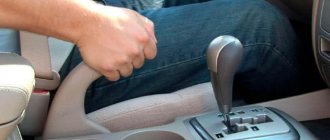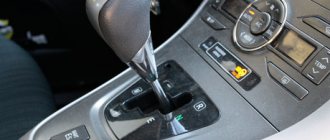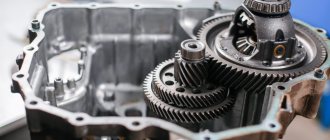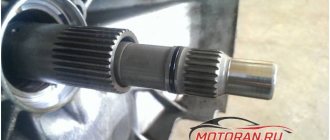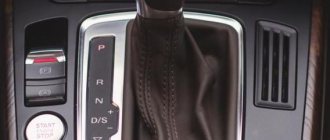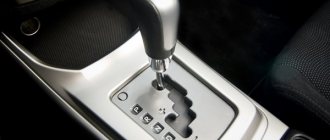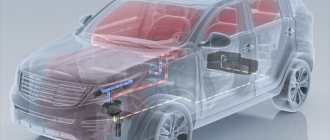Most modern motorists prefer vehicles with automatic transmission, but the level of awareness about the features of their operation is still quite low, in particular, many do not know whether it is possible to tow another car with an automatic transmission. There is no strict prohibition. However, towing cars with an automatic transmission requires taking into account a number of nuances so that the transmission does not fail.
What is the difference between manual transmission and automatic transmission when towing?
When transporting a manual transmission using the towed method, one gear rotates. Moreover, even a switched off engine does not stop the lubrication process.
Towing a car with an automatic transmission is different in that the automatic transmission, when neutral gear is engaged, continues to operate at full power, that is, the entire mechanism is in motion. In this case, the machine inevitably overheats, which ultimately results in a reduction in its service life. The situation is further aggravated by the fact that the oil pump serving the gearbox is correlated with the operation of the internal combustion engine.
Accordingly, towing a vehicle with a switched off internal combustion engine contributes to a catastrophic increase in the risk of machine breakdown, since it will not be provided with oil. Read
Reasons why automatic transmission oil foams and what the driver should do
Rules for towing cars with automatic transmission
Almost all features of this process are specified by the manufacturer. The operating instructions contain a comprehensive answer for each specific vehicle. The instruction that towing should be carried out using a tow truck or partial loading should be strictly followed.
Some drivers ignore the instructions and carry out transportation over short distances using a cable. If you have made such a decision, for which only you are responsible, before starting the process you must:
- Find out the presence and volume of transmission oil in the automatic transmission system.
- Unlock the steering wheel by turning the ignition key in the appropriate lock.
- The automatic transmission lever must be set to position N.
- Strictly observe the regulated speed and distance between vehicles.
- Continuously monitor the coolant temperature and, if necessary, make stops to reduce it.
For long-distance transportation, it is strongly recommended to use a tow truck or partial loading . In any case, remember that towing vehicles with all-wheel drive should only be done with a tow truck. So, despite the fact that a car breakdown can happen at absolutely any time, you should always remember the set of rules for transporting it third-party. Failure to comply with them most often leads to a deterioration in the condition of the car.
Breakdown and subsequent repair of an automatic transmission is very expensive, so it is better not to skimp on a tow truck, so as not to incur large financial losses in the future. In addition, do not forget that a tow truck is an excellent tool for reducing accidents on the road during transportation, as well as eliminating the risk of damage to the car and its paintwork during towing.
Is it possible to tow a car with an automatic transmission?
There is a widespread opinion among car enthusiasts that a vehicle cannot be towed automatically, although few can clearly explain why. Indeed, the design of most types of automatic transmissions is not adapted for operation in this mode, which creates a high risk of failure of various components of the unit due to overloads and overheating. However, if the recommendations are strictly followed, the likelihood of breakdowns will be minimized, and the answer to the question of whether it is possible to tow a car equipped with an automatic transmission will be rather positive.
If the engine is in good condition, then it should be towed with the engine running. First of all, this recommendation is due to the fact that the oil pump functions only when the engine is running, providing lubrication to the machine mechanism. In addition, the power steering and brake systems will operate normally.
The advantage of moving vehicles with the engine running is the elimination of strict restrictions regarding the relocation range established for vehicles with the engine turned off.
More about proper towing with automatic transmission
This is another opinion that differs from all of the above. The leading car should move off as slowly as possible. It is better to control the transmission operating modes in manual mode. They move at first from second speed. And when the speed on the tachometer exceeds 3-3.5 thousand revolutions per minute, you can switch to “L”. And only after this the selector is moved to position “D”.
But overdrive must be turned off. It is absolutely not worth using higher gears, especially if the distances are long. This will reduce the life of the automatic transmission elements. You should move as carefully as possible. There should be no sudden braking or starting. Jerks provoke a dynamic load, which is several times greater than the static one. The weight of the towed car at this moment increases tens of times.
That is why experts recommend using a rigid hitch rather than a towing cable. And yet, the car is on the side of the road and you need to automatically tow another car. Is it possible or not? It turns out that everything is possible, but with extreme caution.
A car with automatic transmission as a tractor
Based on the fact that this type of vehicle is often used for transporting trailers, the answer to the question of whether it is possible to tow another with a car with an automatic transmission will be positive.
However, at the same time, the gearbox experiences enormous loads, therefore, in order to avoid premature failure, certain rules should be followed:
- tow an automatic car with another one equipped with an automatic transmission, only using special couplings;
- do not tow a vehicle whose weight exceeds the tractor;
- drive as smoothly as possible;
- do not press the gas pedal all the way;
- stop regularly.
Read
What are automatic transmission clutches and how to replace them yourself
Following these basic tips will help minimize the likelihood of transmission failure.
General set of rules for towing with automatic transmission
The weight of the vehicle to be towed must not be greater than the weight of the towing vehicle. It's better when it's smaller. Even if there are heavy loads in the other car, it is recommended to transfer them to the front car. This will be less dangerous for the automatic transmission. To the question “is it possible to tow another car of greater weight with an automatic machine,” auto experts answer categorically - no. Naturally, this does not apply to emergency and frankly extreme cases. It is important to check the oil levels in the box before the process. When towing, does oil consumption increase by about 1.5-2 times? and if there is not enough lubrication, then the service life of the box is reduced several times. Experts do not recommend using low gears when towing.
But that's not all. It is not recommended to switch even to position D. It is best to pull another car in 2-3 gear modes. Starting off and the movement itself should be as smooth as possible. You should not start abruptly, with jerks and other sudden movements. There are other recommendations, but they may differ depending on the make and model of the car, the type of automatic transmission installed and some other factors. If these conditions are met, towing is permitted.
Sequence of actions when towing a car with automatic transmission
Before you start towing a car with an automatic transmission, careful preparation for this process is required in order to prevent possible excesses and minimize the risk of transmission failure. The algorithm of actions is as follows:
- check the transmission fluid level and top it up (if possible), if necessary, to the upper limit to ensure better lubrication and better protection against overheating of components;
- perform a rigid coupling of vehicles with each other (again, these are ideal conditions) to avoid jerks, jolts and other sudden movements. You can pull a car with an automatic transmission using a regular cable only if the engine is running and the steering and braking systems are functioning properly;
- switch the machine to neutral operating mode;
- start the engine of the car that will be towed, if possible, and warm it up to 80-90 degrees.
If you have the owner's manual for a specific vehicle at hand, it is advisable to read it, as it contains a lot of useful information on how to tow your car correctly. In particular, it states at what speed a given car model with automatic transmission can be towed.
Some older automatic transmissions have a special feature that allows you to tow the car. Its purpose is to provide a direct connection between the engine shafts and the automatic transmission mechanism, thereby eliminating the damaged torque converter from the working process. If there is such a function in the gearbox, it should be activated before driving, so that towing a car with an automatic transmission is as safe as possible.
Read
Is it possible to start an automatic transmission from a pusher: consequences for automatic transmission
By following basic rules and advice, you can protect the transmission from breakdown and avoid unnecessary expenses.
Selecting a towing vehicle
Towing a car
First, let's talk about the car that will be the towing vehicle. Typically, it should be larger compared to the vehicle it will be towing. You should not use a car that has an automatic mechanism as a towing vehicle. However, if this happens, you need to know exactly what the maximum weight of the towed vehicle is designed for. As a rule, such data is recorded in the operating instructions for the car.
When using an automatic vehicle as a tow vehicle, there are two factors to consider. Load and heat that appears in the hydraulic transformer. This towing option can end in disaster, as the automatic transmission may fail. So before performing such a towing, you need to think everything over a thousand times and imagine the likely consequences.
Towing a car with an automatic transmission with the engine not running
The peculiarity of towing a car with an automatic transmission with the engine not running is that in this state the oil supply system does not function, that is, the gearbox mechanisms rotate without lubrication, which is why the degree of wear of parts increases many times over.
To minimize the negative impact of the car being towed with the engine turned off, it is advisable to adhere to a number of rules:
- start towing the vehicle only after switching the automatic transmission to the neutral position;
- ensure rigid coupling of vehicles with each other;
- move as smoothly as possible;
- tow at low engine speeds;
- adhere to the manufacturer's or generally accepted restrictions regarding the speed and range of non-stop movement.
Some modern car manufacturers directly prohibit towing with the engine turned off, so to find out for sure whether it is possible to tow a specific car automatically with the power unit turned off, it is advisable to read the owner's manual.
How to tow correctly
Since the automatic transmissions installed on different car models can differ significantly from each other, it is best to see whether it is possible to tow another car with an automatic transmission in the car’s instructions. There you can also find information on how long you can pull the car and what speed to adhere to. Manufacturers may set different parameters. But it's rare that they ban towing entirely. Of course, such advice is suitable if the need for towing is known in advance and there is the opportunity and time to study the instructions. When this is not possible (and such situations happen very often), experts and experienced car owners recommend resorting to some kind of “golden mean”.
How many kilometers can you tow a car with an automatic transmission?
In the user manual, the manufacturer usually provides information about at what speed and for how long a specific car model with automatic transmission can be towed.
Read
Which gearbox is better, automatic or manual: pros and cons
In the absence of such data and the impossibility of obtaining it, one should proceed from the following recommendations:
- A vehicle equipped with a three-speed automatic transmission can be towed within 35 km at a speed not exceeding 30 km/h;
- Cars equipped with a gearbox with three or more gears are allowed to be towed for a distance of 50 kilometers, while adhering to a speed limit of 50 km/h.
It is prohibited to exceed the above limits and to pull a vehicle with an automatic transmission with another car over longer distances or faster. If there is more mileage between the start and finish points, then it is important to make stops at specified intervals, giving the rubbing parts the opportunity to cool. In hot weather, it is advisable to increase the break time to one hour.
What about the variator?
The CVT automatic transmission deserves special attention. Here, to find out whether it is possible to tow another car automatically, you need to carefully study the instructions. Thus, for some models of CVT automatic transmissions, it is recommended to install the box in the neutral position.
For others, the engine must be running. For third vehicles, towing may be completely prohibited.
Consequences of transporting a car with an automatic transmission without following the rules
It is important to adhere to the manufacturer’s advice and practice-developed rules for towing a car with an automatic transmission because otherwise the transmission may be seriously damaged due to overheating and insufficient lubrication. The most common faults are presented in the table below.
| Type of malfunction | Nuances |
| Torque converter module burnout | One of the most serious consequences observed if towing is incorrect, and is expressed in the machine slipping or its complete loss of performance. Replacing this component can cost up to 5% of the total price of the vehicle. |
| Melting of gearbox components | Signs of slipping are similar to those above. Repair involves replacing failed parts. |
| Premature wear of machine elements | It is expressed in the transmission slipping in certain operating modes, primarily when moving forward. To return the transmission to working condition, it is necessary to replace worn parts. Most often you have to change clutches. |
Read
Automatic transmission resets and does not shift gears: causes and diagnostics
Other typical breakdowns that may occur if you tow a car with violations are:
- failure of the oil pump;
- gear failure;
- destruction of soft internal components in the variator box;
- malfunctions of the electronics in the robot box.
Each of these problems requires expensive repairs, which is why it is so important to tow according to the basic rules.
How to find out if a car can tow another car
Technically, any vehicle equipped with an eye for attaching a cable can act as a tractor. But it’s one thing to drag another light vehicle ten meters. And it’s another thing to tow another car over a long distance.
You can find out what the car is capable of from its technical characteristics, in the section on the permissible weight of a towed trailer:
- up to 3.5 tons – the car can tow another passenger car;
- 1.5-2 tons - the car will be able to “drag” another passenger car without any damage to the transmission;
- up to 1.5 tons - you can tow minicars weighing up to 1.4 tons, but only in a warm state, if you need to drive a little and on roads without significant or long climbs, with the possibility of several stops to prevent overheating of the transmission and internal combustion engine;
- up to 0.75 tons - it is better to refuse towing, because This will lead to increased wear, which will cause gearbox failure.
Towing with a rigid hitch
There are several advantages to transporting a car this way:
- Eliminating the possibility of a collision between vehicles traveling in a coupled vehicle;
- Does not require additional skills on the part of the driver of the towed vehicle;
- Eliminates the need for the second driver to brake.
The process of transporting an emergency vehicle on a rigid hitch is simple: attach the device; the engine of the emergency vehicle starts; an emergency sign and other identification elements are equipped. Towing a vehicle with a rigid hitch requires concentration from both drivers, especially when driving in the winter.

